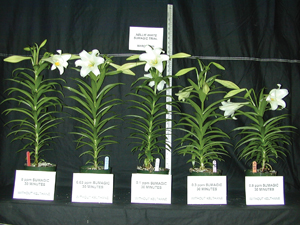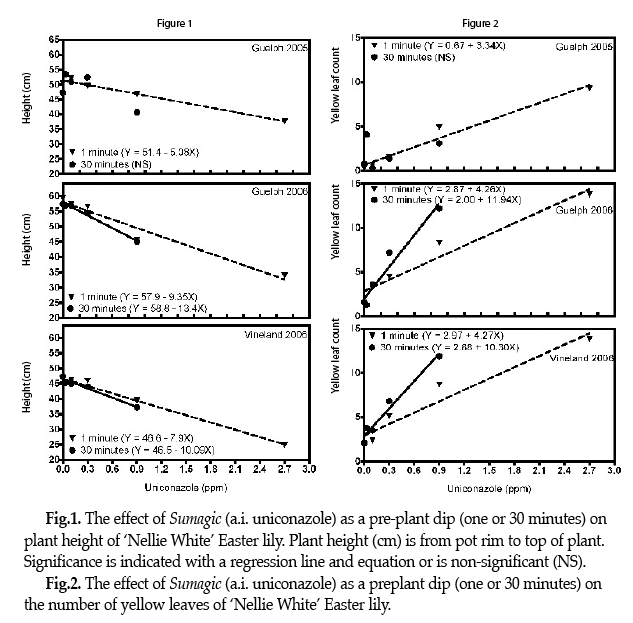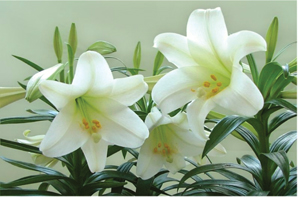
Features
Crop Culture
Inputs
Height control of Easter lilies
November 11, 2008 By Theo J. Blom and Dave Kerec (Univ. of Guelph) and Wayne Brown (OMAFRA)
Since the early
1990s, Sumagic (uniconazole-P) has been used as a growth retardant in
the floricultural industry. According to the manufacturer, Sumagic
offers a broad label for use on numerous plant species,
Sumagic bulb dip use for growth regulation
 |
 |
 |
| The effect of dipping Easter lily bulbs in a Sumagic solution at different concentrations for one minute (Top), 30 minutes w/o Kelthane (Middle), or 30 minutes with Kelthane (Bottom). |
Introduction: Since the early 1990s, Sumagic (uniconazole-P) has been used as a growth retardant in the floricultural industry. According to the manufacturer, Sumagic offers a broad label for use on numerous plant species, from bedding plants and flowering potted plants like poinsettia to woody ornamentals. When applied to plants, Sumagic triggers denser, more compact growth, darker green foliage and increased plant shelf life. No phytotoxicity has been reported when used properly. Regardless of whether Sumagic is applied as a spray or drench, it essentially inhibits production/action of the plant hormone gibberellic acid (GA). The result is a shorter plant.
The most common methods of application are either by spray or drench. However, contemporary research conducted by Dr. Mark Bridgen and Margaret Saska at Cornell University showed that using Sumagic as a preplant dip on Easter lilies held some promise. In their trial, bulbs were submersed in 2.5 ppm of Sumagic for one minute prior to planting. The result was a final plant height that was about half the height of the control plants. Unfortunately, the treated plants were unsalable because the minimum industry requirements for height were not met.
In addition, growers who use Kelthane as a pre-plant miticide dip require dip rates based on 30 minutes of Kelthane submersion. Research is needed to ensure there are no adverse effects on the
bulbs/plants from using Kelthane and Sumagic together in a submersion tank mix. If these two chemicals can be used successfully in a chemical cocktail, then pest control and growth regulation can be done at the same time. As a result, the efficiency of a growers’ operation is increased.
The objective of this study was to determine the most suitable bulb dip concentration and duration using Sumagic in combination with and without Kelthane.
MATERIALS AND METHODS
Year 1 — ‘Nellie White’ (8/9) Easter lily bulbs were treated with Sumagic as a single preplant dip application on Jan. 25, 2005. Due to the late arrival of the case-cooled bulbs, all treated bulbs had a sprout of about 1-2 cm sticking out above the bulb. Four different rates were used along with two different dip durations (one minute and 30 minutes) and two control conditions (water dip only). Bulbs were completely submerged when dipped. For the one-minute dip, the solution contained 0, 0.1, 0.3, 0.9 or 2.7 ppm uniconazole, while for the 30-minute dip, the concentrations were 0, 0.03, 0.1, 0.3 or 0.9 ppm. Only the 30-minute dip application treatments were done with or without Kelthane. Each treatment consisted of 10 bulbs. The control treatments consisted of bulbs dipped in water only, for either one or 30 minutes.
Shortly after treatment, the bulbs were potted into 15-cm standard pots using Sunshine mix #4 growing media and then forced in a glass greenhouse at 18ºC D/N (0 DIF) under ambient light conditions. All plants were watered overhead at 375 ppm N (nitrogen) and 310 ppm K (potassium). No other growth retarding techniques were used.
Year 2 — In the fall of 2005, the same treatments were applied on ‘Nellie White’ (8/9) bulbs on Dec. 1, 2005, and shortly after treatment the bulbs were planted and placed in a 16ºC greenhouse at Vineland Station. On Jan. 10, 2006, one-half of the bulbs of each treatment were moved to a glasshouse at the Bovey Greenhouses, University of Guelph, and forced at 18ºC. All plants were watered overhead at 375 ppm N (nitrogen) and 310 ppm K (potassium). No other growth retarding techniques were used.
Plant parameters measured — When the first flower bud opened on a per plant basis, the following parameters were evaluated: flowering date (the date that the first flower started to open); plant height (measured from top of the pot to the base of the inflorescence, and from the top of the pot to the highest point of the plant); the number of healthy as well as aborted buds; and the number of yellow leaves.
RESULTS: Plant height
Plant height decreased with increasing Sumagic concentration (Fig. 1). At very low concentrations (<0.3 ppm), there was very little noticeable effect on plant height. The effect in 2005 appeared to be slightly smaller than in 2006, but was likely due to the annual effect as well as the fact that the sprouts were about 8-10 cm long at planting for the 2005 forcing year (end of January). In 2006, overall plant height in Vineland was about 12 cm shorter than at the University of Guelph. Other than the temperature (there were no differences in fertilizer type/concentration, no carbon dioxide added in either case, and both locations used glass greenhouses), there were no other notable differences. It has been shown before that forcing Easter lilies warmer will create a taller plant (not all plant species do this, e.g. freesia, hydrangeas, anemones, tulips, primula grow bigger with lower temperatures).
Plant height was lower with increasing Sumagic concentration and with the response being stronger with the 30 minutes compared to the one minute duration (steeper slope!). It should be noted that there was no visible effect from the Sumagic treatments until about the third or fourth week of January, when the transpiration rates started to increase and the effect of Sumagic became visible (this was 7-8 weeks after the treatment!). The addition of Kelthane in the 30-minute treatments did not affect plant height in any of the two years.
 |
RESULTS: Flowering date and number of healthy primary, secondary and tertiary buds
 |
Sumagic dips did not affect either the flowering date or the number of leaves. Easter lilies at University of Guelph were forced about nine days faster than those in Vineland! Note the forcing date is the Julian date +31 (bulbs were potted on Dec.1, 2005). This is likely due to the fact that the forcing temperature was about 18-19ºC at the University of Guelph, while it was about 16ºC in Vineland (see also previous comments).
The addition of Kelthane to the Sumagic in the 30-minute treatments did not have a consistent effect on flowering date and no effect on the number of flower buds.
RESULTS: Number of yellow leaves
The mean number of yellow leaves increased linearly with the Sumagic
concentration, and the slope was greater (twice the slope) for the 30 minutes duration compared with the one-minute treatment (Fig. 2). Interestingly, the stronger the effect of Sumagic on plant height the greater the number of yellow leaves that was present.
SUMMARY
To achieve a final plant height at shipping of about 40-45 cm or 55-60 cm (22-24”) in total (pot included), a bulb dip of 1 ppm of uniconazole (Sumagic) for 1-30 minutes can give you adequate control with no need for additional growth control measures. The duration had a relatively small effect on plant height but a very strong negative effect on yellow leaves.
On the other hand, longer submersion of the bulbs in the solution may provide a more uniform response from the whole group of plants. One should keep in mind that the absorption of the solution depends also on the hydration status of the bulbs. The bulbs were washed in California/Oregon and therefore one might expect less absorption than with unwashed bulbs. The moisture of the peat moss for packing the bulbs may also affect the hydration status of the bulbs.
The effect of Sumagic concentration on yellow leaves was significant. In 1978/79, Tsujita et al not only showed that lower leaf yellowing increased with higher drench rates of A-Rest (ancymidol) but that the incidence of A-Rest induced leaf yellowing could be reduced through increased phosphorous fertilization. In the current study, plants received no phosphorousfertilization. Additional studies to determine
if there is a phosphorous/uniconazole interaction could prove useful if growers plan to adopt a pre-plant bulb dip of Sumagic.
The addition of Kelthane to the Sumagic in the 30-minute dip did not change the effect of the Sumagic on any of the parameters measured. It should be noted that this is not a registered use of Sumagic.
REFERENCES
Bridgen, M. and Saska, M., 2004 “Cornell researchers have found that using preplant growth regulator dips with Easter lily bulbs aids in production and increases profits.” Greenhouse Grower, Issue 12: pp 80-84.
Tsujita, M.J., D.P.Murr, and A.G. Johnson. 1978. Influence of phosphorous nutrition and ancymidol on leaf senescence and growth of Easter lily.
Can J. Plant Sci. 58:287-290.
Tsujita, M.J., D.P. Murr, and A.G. Johnson. 1979. Leaf senescence of Easter lily as influenced by root/shoot growth, phosphorous nutrition and ancymidol. Can J. Plant Sci. 59:757-761.
Print this page